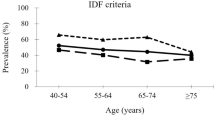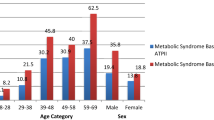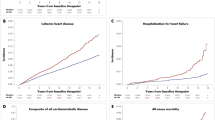Abstract
Limited information is available regarding risk of cardiovascular disease and trends for the metabolic syndrome in Asia. We examined the impact of the metabolic syndrome and its components on risk of cardiovascular disease among middle-aged Japanese according to four criteria. We followed 2,613 subjects from a rural Japanese community who participated in cardiovascular health examinations between 1990 and 1993. After 27,477 person-years of follow-up through 2003, there were 42 incidents of ischemic heart disease, 73 total strokes (54 ischemic and 18 hemorrhagic), and 115 total cases of cardiovascular disease. The metabolic syndrome was defined according to the National Cholesterol Education Program Adult Treatment Panel III (NCEP-ATPIII), American Heart Association/National Heart, Lung, and Blood Institute (AHA/NHLBI), International Diabetes Federation (IDF), and Japanese criteria. The multivariable hazard ratios (95%CI) associated with the metabolic syndrome based on NCEP-ATPIII criteria were 2.1 (1.1–4.0) for ischemic heart disease, 1.7 (1.0–2.7) for total stroke, 2.0 (1.2–3.5) for ischemic stroke, 1.1 (0.4–2.8) for hemorrhagic stroke, 2.0 (1.3–3.1) for ischemic cardiovascular disease, and 1.7 (1.2–2.5) for total cardiovascular disease. The population- attributable fractions of the metabolic syndrome based on NCEP-ATPIII criteria were 26–27% for ischemic heart disease and ischemic stroke and 20% for total cardiovascular disease. The metabolic syndrome based on AHA/NHLBI, IDF and Japanese criteria had weaker associations with risk of cardiovascular disease, and the association with risk of ischemic heart disease was not statistically significant. The metabolic syndrome based on NCEP-ATP III criteria predicted risks of ischemic heart disease, ischemic stroke and total cardiovascular disease, whereas that based on three other criteria predicted them less effectively.
Similar content being viewed by others
Article PDF
References
Earl SF : Risks for all-cause mortality, cardiovascular disease, and diabetes associated with the metabolic syndrome. Diabetes Care 2005; 28: 1769–1778.
Lorenzo C, Williams K, Hunt KJ, Haffner SM : Trend in the prevalence of the metabolic syndrome and its impact on cardiovascular disease incidence. Diabetes Care 2006; 29: 625–630.
Rutter MK, Meigs JB, Sullivan LM, D’Agostino RB, Wilson PWF : C-reactive protein, the metabolic syndrome, and prediction of cardiovascular events in the Framingham Offspring Study. Circulation 2004; 110: 380–385.
Malik S, Wong ND, Franklin SS, et al: Impact of the metabolic syndrome on mortality from coronary heart disease, cardiovascular disease, and all causes in United States adults. Circulation 2004; 110: 1245–1250.
Hunt KJ, Resendez RG, Williams K, Haffner SM, Stern MP : National Cholesterol Education Program versus World Health Organization metabolic syndrome in relation to allcause and cardiovascular mortality in the San Antonio Heart Study. Circulation 2004; 110: 1251–1257.
Lakka H–M, Laaksonen DE, Lakka TA, et al: The metabolic syndrome and total and cardiovascular disease mortality in middle–aged men. JAMA 2002; 288: 2709–2716.
Frod ES : The metabolic syndrome and mortality from cardiovascular disease and all causes: findings from the National Health and Nutrition Examination Survey II Mortality Study. Atherosclerosis 2004; 173: 309–314.
Guzder RN, Gatling W, Mullee MA, Bryne CD : Impact of metabolic syndrome criteria on cardiovascular disease risk in people with newly diagnosed type 2 diabetes. Diabetologia 2006; 49: 49–55.
Expert Panel on Detection, Evaluation, and Treatment of High Blood Cholesterol in Adults : Executive summary of the Third Report of the National Cholesterol Education Program (NCEP) Expert Panel on Detection, Evaluation, and Treatment of High Blood Cholesterol in Adults (Adult Treatment Panel III). JAMA 2001; 285: 2486–2497.
Grundy SM, Cleeman JI, Daniels SR, et al: Diagnosis and management of the metabolic syndrome: an American Heart Association/National Heart, Lung, and Blood Institute Scientific Statement. Circulation 2005; 112: 2735–2752.
Alberti KGMM, Zimmet P, Shaw J : Metabolic syndrome—a new world–wide definition. A consensus statement from the International Diabetes Federation. Diabetes Care 2006; 23: 469–480.
Definition and diagnosis criteria of metabolic syndrome—Committee to Evaluate Diagnostic Standards for Metabolic Syndrome. Nippon Naika Gakkai Zasshi 2005; 94: 794–809(in Japanese).
Iso H, Sato S, Kitamura A, et al: Metabolic syndrome and the risk of ischemic heart disease and stroke among Japanese men and women. Stroke 2007; 38: 1744–1751.
Sone H, Mizuno S, Fuji H, et al: Is the diagnosis of metabolic syndrome useful for predicting cardiovascular disease in Asian diabetic patients? Diabetes Care 2005; 8: 1463–1471.
Sone H, Tanaka S, Ishibashi S, et al: The new worldwide definition of metabolic syndrome is not a better diagnostic predictor of cardiovascular disease in Japanese diabetic patients than the existing definitions. Diabetes Care 2006; 29: 145–147.
Ninomiya T, Kubo M, Doi Y, et al: Impact of metabolic syndrome in the development of cardiovascular disease in a general Japanese population: the Hisayama Study. Stroke 2007; 38: 2063–2069.
Chien KL, Hsu HC, Sung FC, Su TC, Chen MF, Lee YT : Metabolic syndrome as a risk factor for coronary heart disease and stroke: an 11 year prospective cohort in Taiwan community. Atherosclerosis 2007; 194: 214–221.
Chen HJ, Bai CH, Yeh WT, Chiu HC, Pan WH : Influnce of metabolic syndrome and general obesity on the risk of ischemic stroke. Stroke 2006; 37: 1060–1064.
Shimamoto T, Iso H, Tanigawa T, et al: Stroke, ischemic heart disease and their risk factors in Kyowa town, Ibaraki, Japan. Cardioangiology 2000; 48: 127–133 (in Japanese).
WHO Expert Committee : Arterial Hypertension and Ischemic Heart Disease, Preventive Aspect ( WHO technical report series No. 23). Geneva, World Health Organization, 1962.
Shimamoto T, Komachi Y, Inada H, et al: Trends for coronary heart disease and stroke and their risk factors in Japan. Circulation 1989; 79: 503–515.
Iso H, Rexrode K, Hennekens CH, Manson JE : Application of computer tomography—oriented criteria for stroke subtype classification in a prospective study. Ann Epidemiol 2000; 10: 81–87.
Nakamura M, Sato S, Shimamoto T : Improvement in Japanese clinical laboratory measurements of total cholesterol and HDL-cholesterol by the US cholesterol reference method laboratory networks. J Atheroscler Thromb 2003; 10: 145–153.
World Health Organization Western Pacific Region, International Association for the Study of Obesity and the International Obesity Task Force : The Asia-Pacific Perspective: Redefining Obesity and Its Treatment. Sydney, Health Communication Australia Pty Limited, 2000, p 1102.
Rockhill B, Newman B, Weinberg C : Use and misuse of population attributable fractions. Am J Public Health 1998; 88: 15–19.
Greenland S : Re: "Confidence limits made easy: interval estimation using a substitution method." Am J Epidemiols 1999; 149: 884–886.
Kadota A, Hozawa A, Okamura T, et al: NIPPON DATA Research Group: Relationship between metabolic risk factor clustering and cardiovascular mortality stratified by high blood glucose and obesity: NIPPON DATA90, 1990−2000. Diabetes Care 2007; 30: 1533–1538.
Takeuchi H, Saitoh S, Takagi T, et al: Metabolic syndrome and cardiac disease in Japanese men: applicability of the concept of metabolic syndrome defined by the National Cholesterol Education Program—Adult Treatment Panel III to Japanese men—The Tanno and Sobetsu Study. Hypertens Res 2008; 28: 203–208.
Yoon YS, Lee ES, Park C, Lee S, Oh SW : The new definition of metabolic syndrome by the international diabetes federation is less likely to identify metabolically abnormal but non–obese individuals than the definition by the revised national cholesterol education program: the Korea NHANES Study. Int J Obes 2007; 31: 528–534.
Tong PC, Ozaki R Kong AP, et al: The usefulness of the International Diabetes Federation and the National Cholesterol Education Program’s Adult Treatment Panel III definitionsof the metabolic syndrome in predicting coronary heart disease in subjects with type 2 diabetes. Diabetes Care 2007; 30: 1206–1211.
Nilsson PM, Engstrom G, Hedblad B : The metabolic syndrome and incidence of cardiovascular disease in non–diabetic subjects—a population–based study comparing three different definitions. Diabet Med 2007; 24: 464–472.
Katzmarzyk PT, Janssen I, Ross R, Church TS, Blair SN, et al: The importance of waist circumference in the definition of metabolic syndrome. Diabetes Care 2006; 29: 404–409.
Yasuda T, Matsuhisa M, Fujiki N, et al: Is central obesity a good predictor of carotid atherosclerosis in Japanese type 2 diabetes with metabolic syndrome? Endocr J 2007; 54: 695–702.
Iso H, Naito Y, Sato S, et al: Serum triglycerides and risk of coronary heart disease among Japanese men and women. Am J Epidemiol 2001; 153: 490–499.
Author information
Authors and Affiliations
Corresponding author
Rights and permissions
About this article
Cite this article
Chei, CL., Yamagishi, K., Tanigawa, T. et al. Metabolic Syndrome and the Risk of Ischemic Heart Disease and Stroke among Middle-Aged Japanese. Hypertens Res 31, 1887–1894 (2008). https://doi.org/10.1291/hypres.31.1887
Received:
Accepted:
Issue date:
DOI: https://doi.org/10.1291/hypres.31.1887
Keywords
This article is cited by
-
The Japanese Society of Hypertension Guidelines for the Management of Hypertension (JSH 2019)
Hypertension Research (2019)
-
Chapter 1. Epidemiology of hypertension
Hypertension Research (2014)
-
A Japanese health success story: trends in cardiovascular diseases, their risk factors, and the contribution of public health and personalized approaches
EPMA Journal (2011)
-
Association of gene polymorphism of the fat-mass and obesity-associated gene with insulin resistance in Japanese
Hypertension Research (2010)
-
The impact of the metabolic syndrome and its components on the incidence of ischemic heart disease and stroke: the Japan public health center-based study
Hypertension Research (2009)



